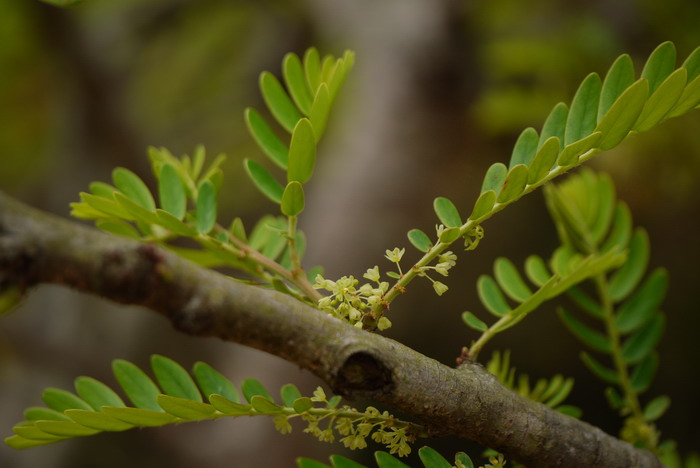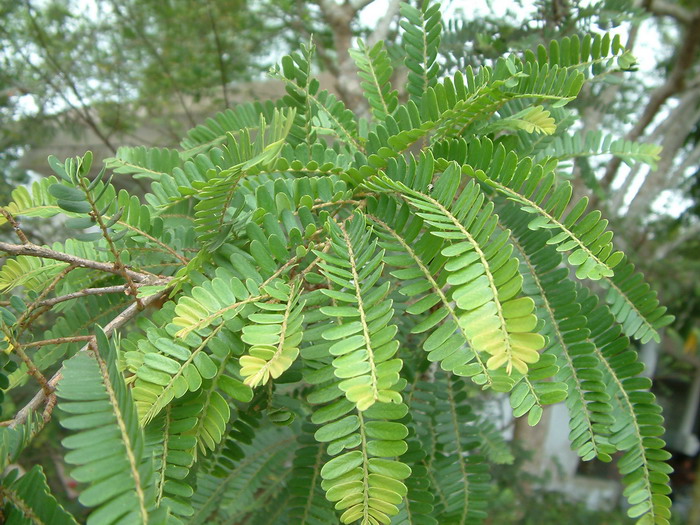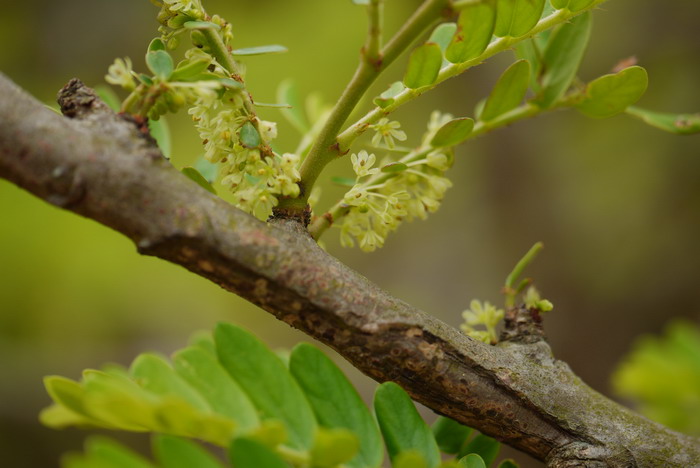余甘子Phyllanthus emblica
中文名(Chinese Name):余甘子
学名(Scientific Name):Phyllanthus emblica L.
英文名(English Common Name):emblic
别名(Chinese Common Name):油甘子
异名(Synonym):Dichelactina nodicaulis Hance Diasperus emblica (L.) Kuntze Emblica officinalis Gaertn. Phyllanthus mairei H. Lév. Phyllanthus glomeratus Roxb. ex Wall. Phyllanthus mimosifolius Salisb. Phyllanthus taxifolius D.Don Cicca emblica (L.) Kurz Emblica arborea Raf.
科属(Family & Genus):大戟科(Euphorbiaceae)叶下珠属
形态特征(Description):乔木,高达23米,胸径50厘米;树皮浅褐色;枝条具纵细条纹,被黄褐色短柔毛。叶片纸质至革质,二列,线状长圆形,长8-20毫米,宽2-6毫米,顶端截平或钝圆,有锐尖头或微凹,基部浅心形而稍偏斜,上面绿色,下面浅绿色,干后带红色或淡褐色,边缘略背卷;侧脉每边4-7条;叶柄长0.3-0.7毫米;托叶三角形,长0.8-1.5毫米,褐红色,边缘有睫毛。多朵雄花和1朵雌花或全为雄花组成腋生的聚伞花序;萼片6;雄花:花梗长1-2.5毫米;萼片膜质,黄色,长倒卵形或匙形,近相等,长1.2-2.5毫米,宽0.5-1毫米,顶端钝或圆,边缘全缘或有浅齿;雄蕊3,花丝合生成长0.3-0.7毫米的柱,花药直立,长圆形,长0.5-0.9毫米,顶端具短尖头,药室平行,纵裂;花粉近球形,直径17.5-19微米,具4-6孔沟,内孔多长椭圆形;花盘腺体6,近三角形;雌花:花梗长约0.5毫米;萼片长圆形或匙形,长1.6-2.5毫米,宽0.7-1.3毫米,顶端钝或圆,较厚,边缘膜质,多少具浅齿;花盘杯状,包藏子房达-半以上,边缘撕裂;子房卵圆形,长约1.5毫米,3室,花柱3,长2.5-4毫米,基部合生,顶端2裂,裂片顶端再2裂。蒴果呈核果状,圆球形,直径1-1.3厘米,外果皮肉质,绿白色或淡黄白色,内果皮硬壳质;种子略带红色,长5-6毫米,宽2-3毫米。花期4-6月,果期7-9月。
分布(Distribution):产江西、福建、台湾、广东、海南、广西、四川、贵州和云南等省区,生于海拔200-2300米山地疏林、灌丛、荒地或山沟向阳处。中南半岛及东南亚也有。
用途(Use):
引自中国植物志英文版FOC Vol. 11 Page 163, 180, 182
Phyllanthus emblica Linnaeus, Sp. Pl. 2: 982. 1753.
余甘子 yu gan zi | Euphorbiaceae | Phyllanthus
Diasperus emblica (Linnaeus) Kuntze; Dichelactina nodicaulis Hance; Emblica officinalis Gaertner; Phyllanthus mairei H. Léveillé.
Trees 3-8(-23) m tall, to 50 cm d.b.h., monoecious, deciduous; bark brownish; main stems terete, sparsely lenticellate, with very reduced short shoots producing groups of leafy shoots; leafy shoots angular, tawny pubescent, at start of growing season often with poorly developed leaves and densely flowered, later with fewer flowers and better-developed leaves. Leaves distichous; stipules triangular-ovate, 0.8-1.5 mm, brown, margins entire or denticulate, ciliate; petiole 0.3-0.7 mm; leaf blade oblong or linear-oblong, 8-23 × 1.5-6 mm, papery to leathery, paler abaxially, green adaxially, drying reddish or brownish, base shallowly cordate and slightly oblique, margin narrowly revolute, apex truncate, rounded or obtuse, mucronate or retuse at tip; lateral veins 4-7 pairs. Fascicles with many male flowers and sometimes 1 or 2 larger female flowers. Male flowers: pedicels 1-2.5 mm; sepals 6, membranous, yellow, obovate or spatulate, subequal, 1.2-2.5 × 0.5-1 mm, apex obtuse or rounded, margin entire or shallowly denticulate; disk glands 6, subtriangular; stamens 3; filaments coherent into column, 0.3-0.7 mm; anthers erect, oblong, 0.5-0.9 mm, longitudinally dehiscent, apex mucronate. Female flowers: pedicels ca. 0.5 mm; sepals 6, oblong or spatulate, 1.6-2.5 × 0.7-1.3 mm, apex obtuse or rounded, thicker, margin membranous, ± lobate; ovary ovoid, ca. 1.5 mm, 3-celled; styles 3, (1-)2.5-4 mm, connate at base, deeply bifid, lobes divided at tip. Fruit a drupe, globose, 1-1.3 cm in diam., exocarp fleshy, pale green or yellowish white, endocarp crustaceous. Seeds reddish, 5-6 × 2-3 mm. Fl. Apr-Jun, fr. Jul-Sep.
Dry open sparse forests or scrub, village groves; 200-2300 m. Fujian, Guangdong, Guangxi, Guizhou, Hainan, Jiangxi, Sichuan, Taiwan, Yunnan [Bhutan, Cambodia, India, Indonesia, Laos, Malaysia, Myanmar, Nepal, Philippines, Sri Lanka, Thailand; South America (cultivated)].
The mature fruits are very sour and contain 1%-1.8% Vitamin C. They are eaten raw or sweetened or preserved. The seeds, roots, and leaves are used as medicine. The dried leaves are sometimes used as fillings in pillows.



(责任编辑:徐晔春)
学名(Scientific Name):Phyllanthus emblica L.
英文名(English Common Name):emblic
别名(Chinese Common Name):油甘子
异名(Synonym):Dichelactina nodicaulis Hance Diasperus emblica (L.) Kuntze Emblica officinalis Gaertn. Phyllanthus mairei H. Lév. Phyllanthus glomeratus Roxb. ex Wall. Phyllanthus mimosifolius Salisb. Phyllanthus taxifolius D.Don Cicca emblica (L.) Kurz Emblica arborea Raf.
科属(Family & Genus):大戟科(Euphorbiaceae)叶下珠属
形态特征(Description):乔木,高达23米,胸径50厘米;树皮浅褐色;枝条具纵细条纹,被黄褐色短柔毛。叶片纸质至革质,二列,线状长圆形,长8-20毫米,宽2-6毫米,顶端截平或钝圆,有锐尖头或微凹,基部浅心形而稍偏斜,上面绿色,下面浅绿色,干后带红色或淡褐色,边缘略背卷;侧脉每边4-7条;叶柄长0.3-0.7毫米;托叶三角形,长0.8-1.5毫米,褐红色,边缘有睫毛。多朵雄花和1朵雌花或全为雄花组成腋生的聚伞花序;萼片6;雄花:花梗长1-2.5毫米;萼片膜质,黄色,长倒卵形或匙形,近相等,长1.2-2.5毫米,宽0.5-1毫米,顶端钝或圆,边缘全缘或有浅齿;雄蕊3,花丝合生成长0.3-0.7毫米的柱,花药直立,长圆形,长0.5-0.9毫米,顶端具短尖头,药室平行,纵裂;花粉近球形,直径17.5-19微米,具4-6孔沟,内孔多长椭圆形;花盘腺体6,近三角形;雌花:花梗长约0.5毫米;萼片长圆形或匙形,长1.6-2.5毫米,宽0.7-1.3毫米,顶端钝或圆,较厚,边缘膜质,多少具浅齿;花盘杯状,包藏子房达-半以上,边缘撕裂;子房卵圆形,长约1.5毫米,3室,花柱3,长2.5-4毫米,基部合生,顶端2裂,裂片顶端再2裂。蒴果呈核果状,圆球形,直径1-1.3厘米,外果皮肉质,绿白色或淡黄白色,内果皮硬壳质;种子略带红色,长5-6毫米,宽2-3毫米。花期4-6月,果期7-9月。
分布(Distribution):产江西、福建、台湾、广东、海南、广西、四川、贵州和云南等省区,生于海拔200-2300米山地疏林、灌丛、荒地或山沟向阳处。中南半岛及东南亚也有。
用途(Use):
引自中国植物志英文版FOC Vol. 11 Page 163, 180, 182
Phyllanthus emblica Linnaeus, Sp. Pl. 2: 982. 1753.
余甘子 yu gan zi | Euphorbiaceae | Phyllanthus
Diasperus emblica (Linnaeus) Kuntze; Dichelactina nodicaulis Hance; Emblica officinalis Gaertner; Phyllanthus mairei H. Léveillé.
Trees 3-8(-23) m tall, to 50 cm d.b.h., monoecious, deciduous; bark brownish; main stems terete, sparsely lenticellate, with very reduced short shoots producing groups of leafy shoots; leafy shoots angular, tawny pubescent, at start of growing season often with poorly developed leaves and densely flowered, later with fewer flowers and better-developed leaves. Leaves distichous; stipules triangular-ovate, 0.8-1.5 mm, brown, margins entire or denticulate, ciliate; petiole 0.3-0.7 mm; leaf blade oblong or linear-oblong, 8-23 × 1.5-6 mm, papery to leathery, paler abaxially, green adaxially, drying reddish or brownish, base shallowly cordate and slightly oblique, margin narrowly revolute, apex truncate, rounded or obtuse, mucronate or retuse at tip; lateral veins 4-7 pairs. Fascicles with many male flowers and sometimes 1 or 2 larger female flowers. Male flowers: pedicels 1-2.5 mm; sepals 6, membranous, yellow, obovate or spatulate, subequal, 1.2-2.5 × 0.5-1 mm, apex obtuse or rounded, margin entire or shallowly denticulate; disk glands 6, subtriangular; stamens 3; filaments coherent into column, 0.3-0.7 mm; anthers erect, oblong, 0.5-0.9 mm, longitudinally dehiscent, apex mucronate. Female flowers: pedicels ca. 0.5 mm; sepals 6, oblong or spatulate, 1.6-2.5 × 0.7-1.3 mm, apex obtuse or rounded, thicker, margin membranous, ± lobate; ovary ovoid, ca. 1.5 mm, 3-celled; styles 3, (1-)2.5-4 mm, connate at base, deeply bifid, lobes divided at tip. Fruit a drupe, globose, 1-1.3 cm in diam., exocarp fleshy, pale green or yellowish white, endocarp crustaceous. Seeds reddish, 5-6 × 2-3 mm. Fl. Apr-Jun, fr. Jul-Sep.
Dry open sparse forests or scrub, village groves; 200-2300 m. Fujian, Guangdong, Guangxi, Guizhou, Hainan, Jiangxi, Sichuan, Taiwan, Yunnan [Bhutan, Cambodia, India, Indonesia, Laos, Malaysia, Myanmar, Nepal, Philippines, Sri Lanka, Thailand; South America (cultivated)].
The mature fruits are very sour and contain 1%-1.8% Vitamin C. They are eaten raw or sweetened or preserved. The seeds, roots, and leaves are used as medicine. The dried leaves are sometimes used as fillings in pillows.
(责任编辑:徐晔春)
踩一下[1]

顶一下[4]